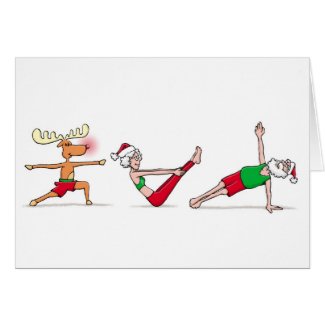Here's a great video for you to get practice ideas from, especially for next week when there'll be no classes at Harmony Yoga.
Gabriella Giubilaro is an Iyengar Yoga teacher from Italy who studies almost every year with B.K.S. Iyengar and his daughter Geeta.
Notes about the video, and suggestions for practice:
- The first 3 1/2 minutes are for show only -- to inspire and maybe to make you laugh :-)
- Many poses are shown in this video. You might decide to do just half, or even less.
- Do the poses as you know how to do them, with the props you need. Gabriella shows some variations if you can't do without props, but also use your own judgement. Work intelligently.
- The list of the poses is after the video.
Observe how strong she is in these asanas. She is very controlled and precise with her movements. A steady body indicates a steady, focused mind.
Here's a Yoga Journal interview with Gabriella.
Talking Shop With Gabriella Giubilaro
For more info on these poses, refer to
recommended Iyengar Yoga books.
Sequence of poses in this video:
Vajrasana with parvatasana - Sit on heels, clasp hands, stretch palms up
Virasana - Sit between heels
Paripurna navasana - Full boat pose
Urdhva prasarita padasana - Leg lifts
Jathara parivartanasana - legs to side (supine twist, knees bent or legs straight)
Ubbhaya padangustasana - Hold toes, lift legs up
Supta padangusthasana - supine leg stretch
Anantasana - lying on side, leg stretch
Adho mukha svanasana -- Downward facing dog
Jump to Uttanasana - Standing forward bend
Come up to Tadasana - standing pose
Utkatasana -- arms up, knees bent
Garudhasana - Eagle Pose
Vrksasana - Tree pose
Utthita Parsvakonasana #1 (down arm in front of bent knee) - side angle pose variation
Utthita trikonasana - Triangle pose
Utthita Parsvakonasana #2 (regular way, down arm behind bent knee) - side angle pose
Virabhadrasana II - Warrior II
Ardha chandrasana - Half moon pose
Parivrtta trikonasana - Revolved triangle pose
Parsvottanasana (paschimonamaskarasana hands, or hands to blocks, chair) - intense side stretch standing forward bend
Prasarita padottanasana - wide legged standing forward bend
Uttanasana hold elbows - standing forward bend
Padangusthasana -- standing forward bend, hold big toes
Padahastasana -- standing forward bend, hands under feet
Adho mukha svanasana
Rest (Adho mukha virasana)
Sirsasana -- head balance
Chaturanga dandasana (or I might do urdhva mukha svanasana) -- plank pose (or instead do upward facing dog)
Ustrasana -- Camel pose
Swastikasana -- forward -- Cross legged seated pose going forward
Swastikasana twist
Chair bharadvajasana -- twist, sitting through back of chair
Marichyasana III -- seated twist, one knee up, twist across bent leg.
Sarvangasana -- shoulderstand -- Come to Halasana (plow pose) first -- roll to top of shoulders, first w/arms bend then clasp hands behind. Then place strap and come up.
Halasana - clasp hands behind
Rest
Janu sirsasana -- seated forward bend, one knee bent out to side
Paschimottanasana -- seated forward bend -- both legs straight
Upavistha Konasana -- wide angle seated pose
With twist
Baddha Konasana -- bound angle pose
Supta virasana -- supine virasana
Supta baddha konasana -- supine baddha konasana
Savasasana -- corpse pose

















